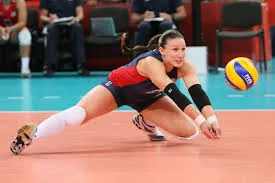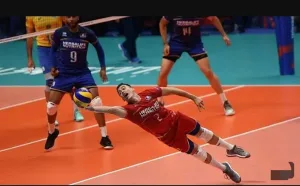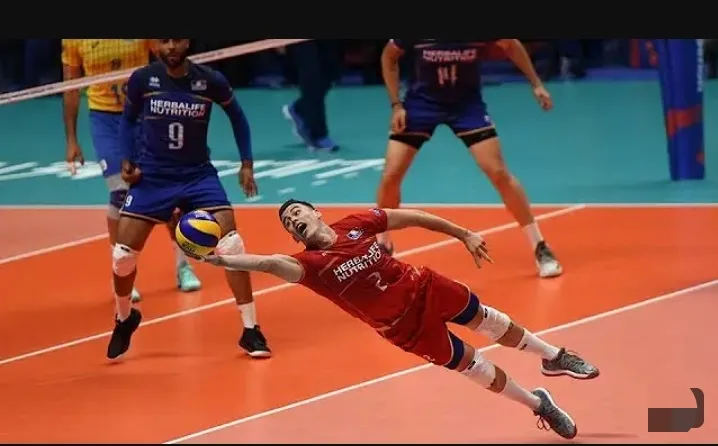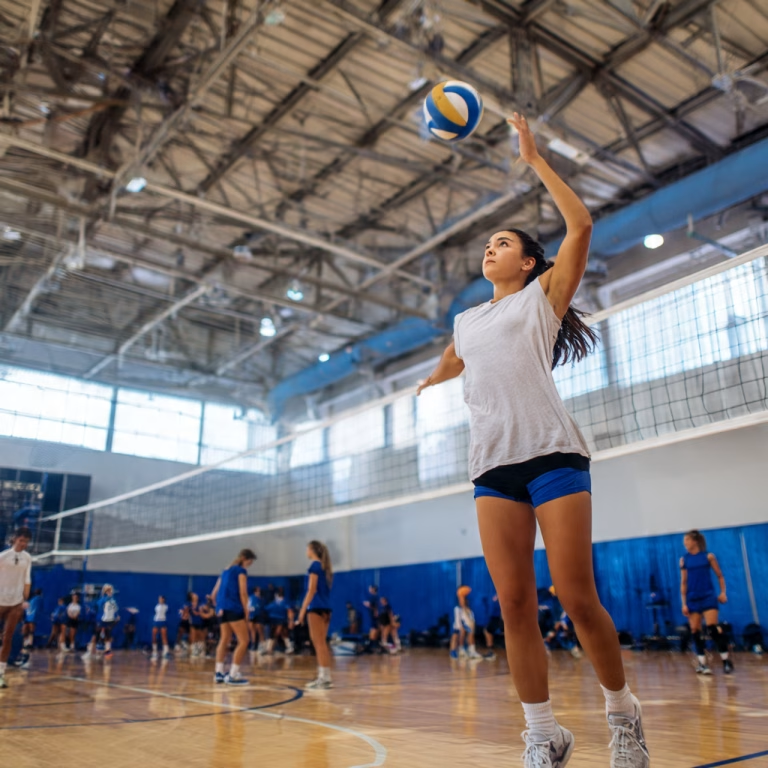The libero in volleyball is one of the most unique and important positions in volleyball. When watching a volleyball game, there’s one player that often stands out because of their unique jersey color.
If you’ve ever watched a volleyball match and noticed such a player wearing a different-colored jersey that is different from the color of other players on their team, that’s the libero.
Now the question is: what exactly does a libero do, and why do they wear a different-colored jersey?
In this article, we shall take a comprehensive look at what the libero in volleyball is all about, including the libero’s rules and responsibilities.
What Does Libero Mean in Volleyball?

The term libero comes from the Italian word meaning “free.” It was introduced to international volleyball in 1998. The libero’s role was designed to enhance the game’s defense and allow smaller, agile players to shine.
A libero is a defensive specialist who cannot attack, block, or serve (in most leagues) but excels in receiving serves, digging spikes, and passing the ball to the setter. Their ultimate goal is to keep the ball alive and set the stage for their teammates to score.
Why Does the Libero Wear a Different Jersey?
The libero wears a different jersey to distinguish themselves from the other players on the court. This distinction is important because:
- The libero has unique rules that allow them to substitute freely without formal substitution.
- It helps referees and coaches monitor their specialized actions and adherence to rules.
Roles and Responsibilities of a Libero in Volleyball
The libero’s duties go far beyond digging spikes or receiving serves. Below are some of their roles and responsibilities during a volleyball match:
1. Passing (Serve Reception)
The libero is often the team’s best passer and plays a crucial role in serve reception. They aim to deliver accurate passes to the setter, initiating a strong offensive play.
2. Defense (Digging)
When opponents attack with powerful spikes, the libero is the team’s last line of defense. Their quick reflexes and strategic positioning make them invaluable for keeping the ball in play.
3. Setting
While not their primary role, the libero can step in as a secondary setter if the main setter is unable to reach the ball. However, they must follow specific rules when setting the ball near the attack line.
4. Leadership and Communication
Liberos often serve as the team’s defensive leader, constantly communicating with teammates about positioning and strategies. Their energy and focus can inspire the entire team.
Libero Rules in Volleyball

To fully understand the libero’s role, it’s essential to know the rules that govern their play. Generally, the libero operates under distinct rules that differ from other players on the court. These rules ensure the libero focuses solely on defense and ball control.
| Rule | Implications |
| Jersey Color | Must wear a contrasting color from the rest of the team. |
| Substitution Rules | Can replace any back-row player without using formal substitution protocols. |
| Restrictions on Attacking | Cannot attack the ball above the net’s height, regardless of their position on the court. |
| Blocking Restrictions | Cannot attempt or participate in a block. |
| Setting Limitations | Cannot set the ball in front of the attack line for an offensive attack. |
| Serving (Varies by League) | Some leagues allow the libero to serve; others do not. |
Difference Between a Libero and Defensive Specialist
Libero and defensive specialist are often used interchangeably, but they are two different positions. Below are a few differences between the libero and defensive specialist positions in volleyball:
| Differences in: | Libero | Defensive Specialist |
| Jersey Color | Wears a contrasting jersey. | Matches the team’s uniform. |
| Substitution Rules | Unlimited substitutions per set. | Substituted like any other player. |
| Position Flexibility | Cannot play in the front row. | Can rotate to the front row. |
| Focus | Exclusively back-row play. | Defensive but more versatile. |
What Makes a Good Libero?
Becoming an exceptional libero requires a combination of physical skills, mental toughness, and strategic thinking. Below are what sets top liberos apart:
- Exceptional Ball Control: A good libero has impeccable ball control, ensuring accurate passes even under pressure.
- Quick Reflexes: Speed and agility are non-negotiable. Liberos must react instantly to powerful spikes and unexpected deflections.
- Court Awareness: Understanding positioning and anticipating opponents’ moves is critical for a libero to excel.
- Communication Skills: A libero must constantly communicate with teammates, ensuring proper defensive alignment and minimizing errors.
- Mental Toughness: The libero often faces high-pressure situations. Staying composed and focused is essential for consistent performance.
See Also: Characteristics of a Libero in Volleyball
Famous Liberos in Volleyball History
Below are some of the greatest liberos in volleyball history:
1. Serginho (Sérgio Dutra Santos)
Widely regarded as one of the best liberos of all time, Serginho played a pivotal role in Brazil’s dominance in international volleyball, earning Olympic gold medals in 2004 and 2016.
2. Jenia Grebennikov
A French libero known for his spectacular defensive plays, Grebennikov has won numerous accolades, including Best Libero awards in international tournaments.
3. Brenda Castillo
Hailing from the Dominican Republic, Castillo is celebrated for her incredible agility and court awareness, earning her recognition as one of the top female liberos in the world.
Read more: 30 Funny Gifts for Volleyball Players
How to Train as a Libero
If you’re aspiring to become a libero, here are some training tips to help you master the position:
1. Practice Passing Drills
Focus on accuracy and consistency in serve-receive scenarios. Use drills that simulate game situations.
2. Work on Reaction Time
Quick reflexes are essential. Use agility drills, such as ladder exercises and reaction ball drills, to improve your speed and reaction time.
3. Develop Defensive Skills
Spend time on digging drills to enhance your ability to handle powerful spikes. Position yourself low and maintain balance for better control.
4. Build Core Strength
Core strength is crucial for stability and explosive movements. Incorporate planks, Russian twists, and other core exercises into your routine.
5. Study the Game
Watch professional liberos in action. Analyze their movements, positioning, and decision-making to gain insights into effective gameplay.
Read More: Top 10 Highest Paid Volleyball Players in the World (2024 update)
FAQs About the Libero Position
Can the libero serve in volleyball?
In some leagues and competitions, the libero is allowed to serve for one rotation. However, international rules often restrict this.
Can a libero be a captain?
It is rare but not prohibited. Some leagues and teams allow liberos to serve as captains if they exhibit strong leadership qualities. But according to FIVB rules, the libero cannot be the team captain during a match.
Why can’t the libero spike or block?
The libero’s primary role is defensive. Allowing them to spike or block would conflict with their specialized purpose.
How many liberos can a team have?
Teams are typically allowed to designate up to two liberos per match, but only one can be on the court at a time.
What’s the difference between a libero and a defensive specialist?
While both focus on defense, the libero has unique substitution rules and positional restrictions, whereas a defensive specialist operates within standard rules.
Can a libero attack from the front row?
No, a libero cannot attack from the front row. They are restricted to the back row.
Can a libero block?
No, a libero cannot block at the net.
What makes a good libero?
A good libero must possess exceptional passing and digging skills, excellent court coverage, quick reflexes, high stamina, and strong teamwork skills.
Can a libero serve?
Yes, a libero can serve, but under FIVB rules, liberos are generally not allowed to serve. However, some leagues, like NCAA volleyball, allow the libero to serve in one rotation.
Why Does the Libero Wear a Different Jersey?
The contrasting jersey helps referees easily identify the libero and enforce the specific rules governing their play.
What Happens If the Libero Breaks the Rules?
If a libero violates any of their restrictions, the opposing team is awarded a point and possession of the serve.
Conclusion
The libero in volleyball is a defensive specialist who plays in the back row. They are known for their exceptional passing, digging, and serving skills.
Liberos are often considered the “anchor” of the team’s defense, as they are responsible for receiving serves, digging attacks, and making crucial passes to the setter. They are also skilled at reading the opponent’s offense and making strategic decisions to shut down their attacks.
One of the unique aspects of the libero position is that they are restricted from blocking and attacking the ball. This means that they must rely on their speed, agility, and court vision to excel in their role.
Liberos are also required to wear a different color jersey than their teammates, making them easily identifiable on the court. Despite their limitations, liberos play a critical role in their team’s success, and their expertise is often the key to winning matches. Their exceptional defensive skills and strategic thinking make them valuable players on any volleyball team.




